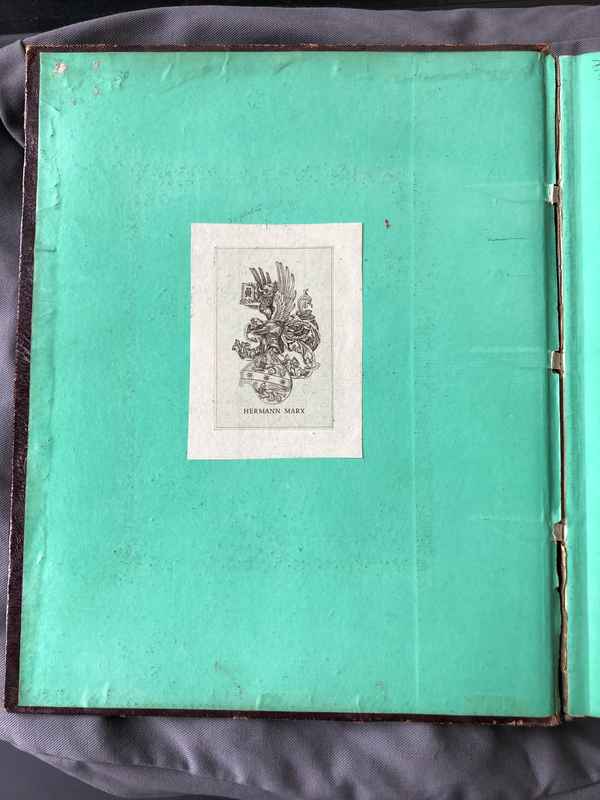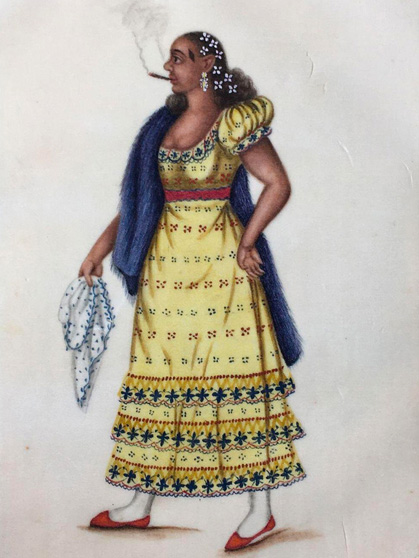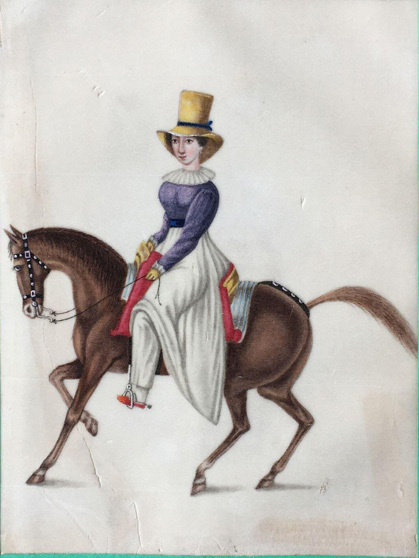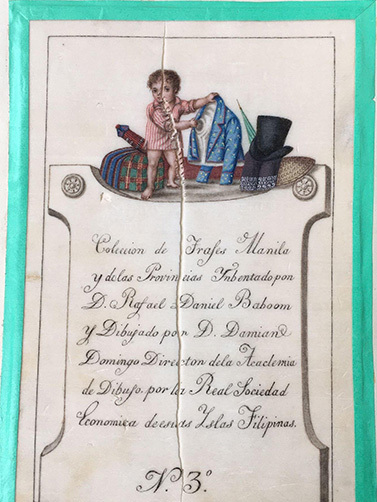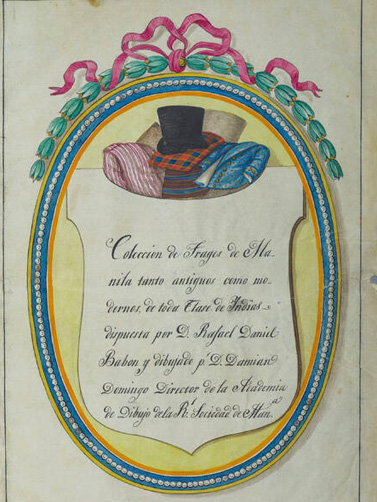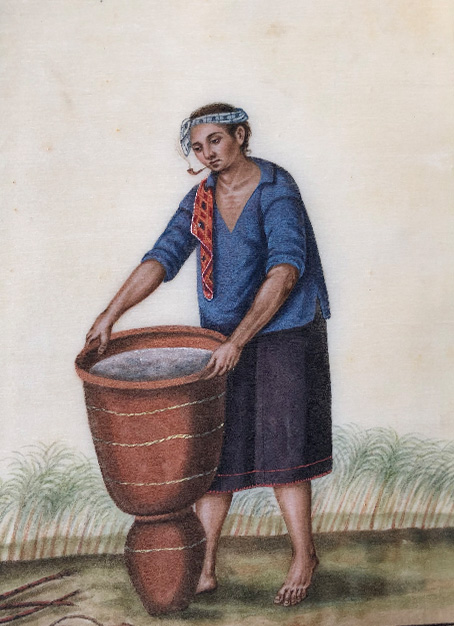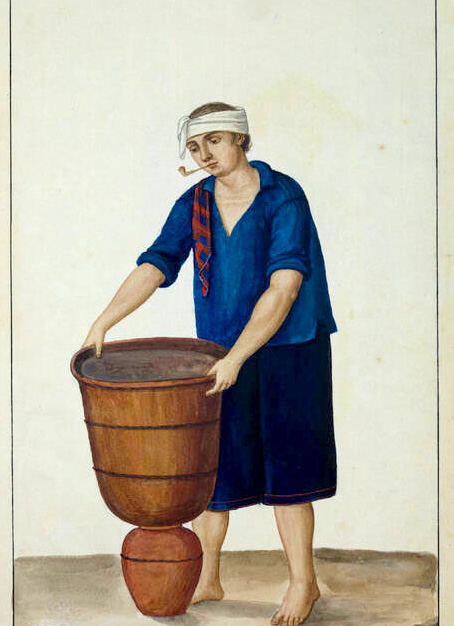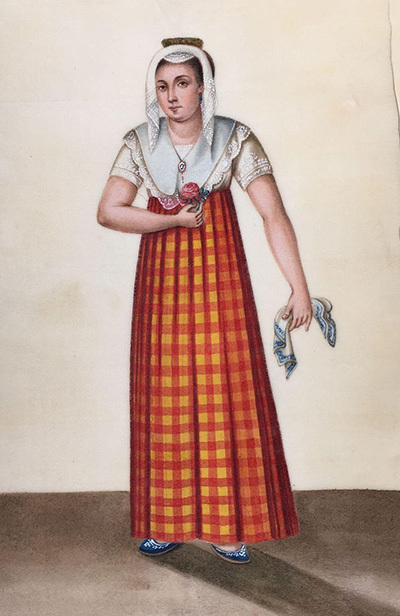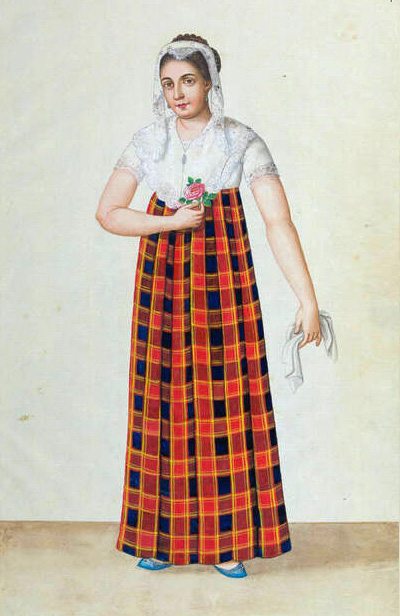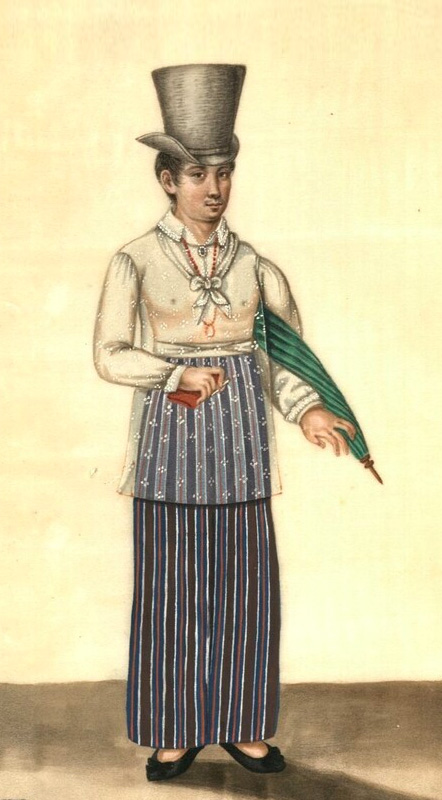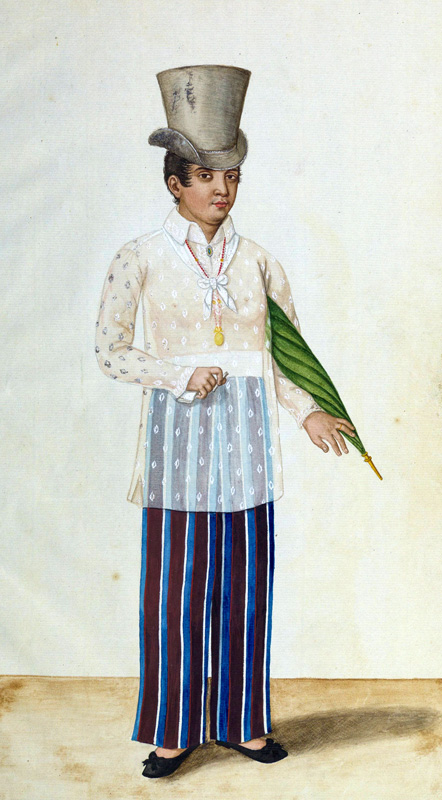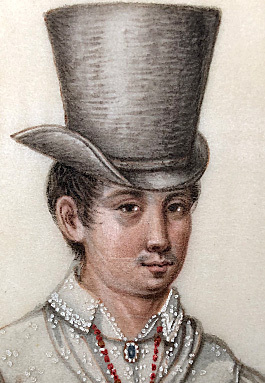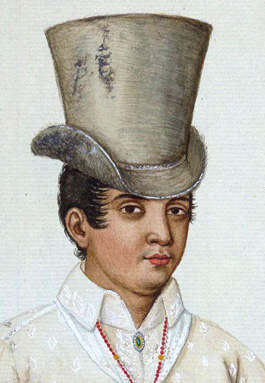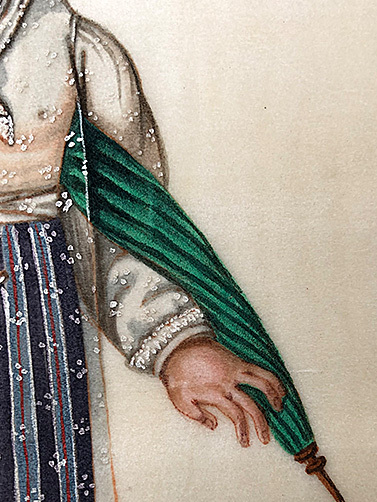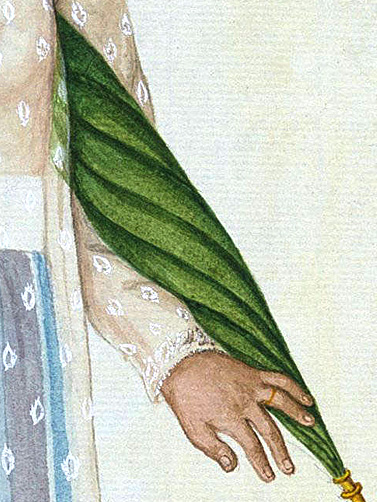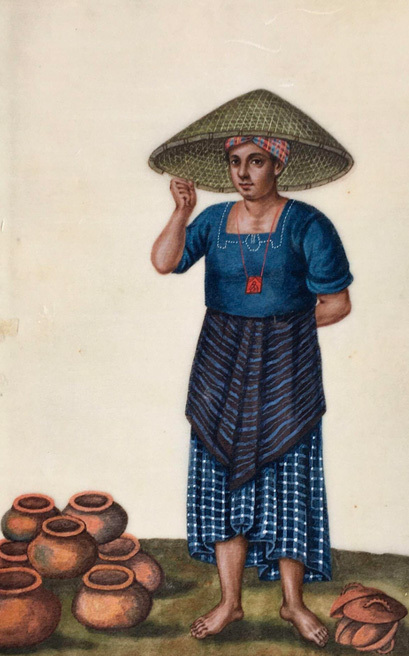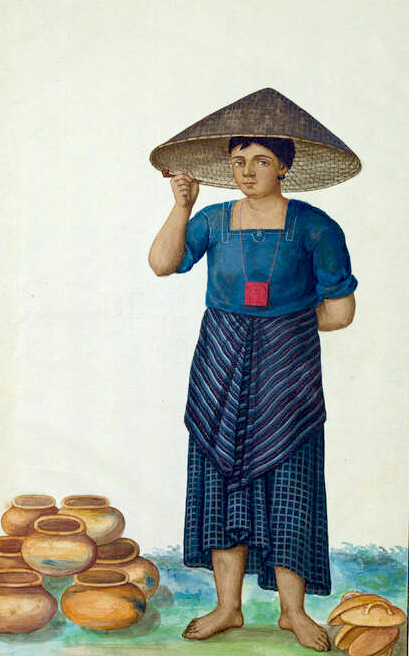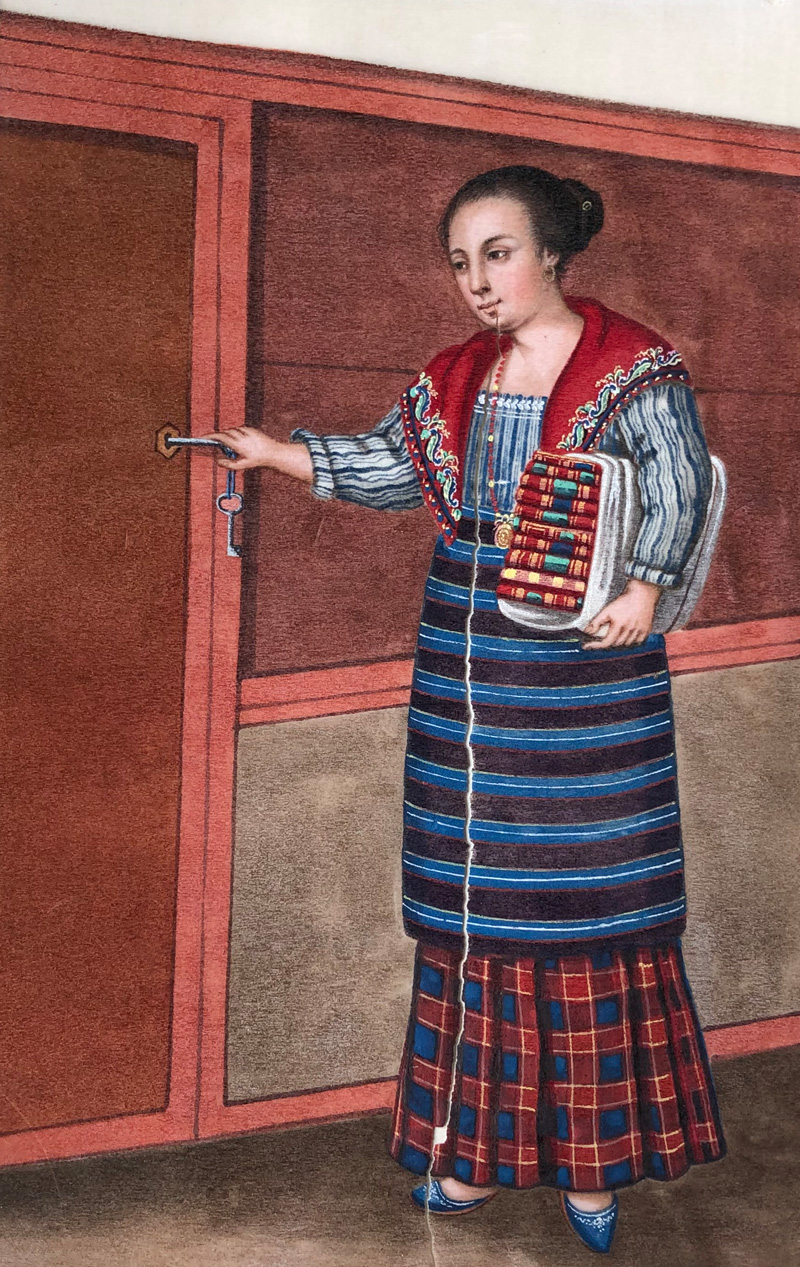On Finding Damian Domingo at the Victoria and Albert Museum in London
Exhibit Description
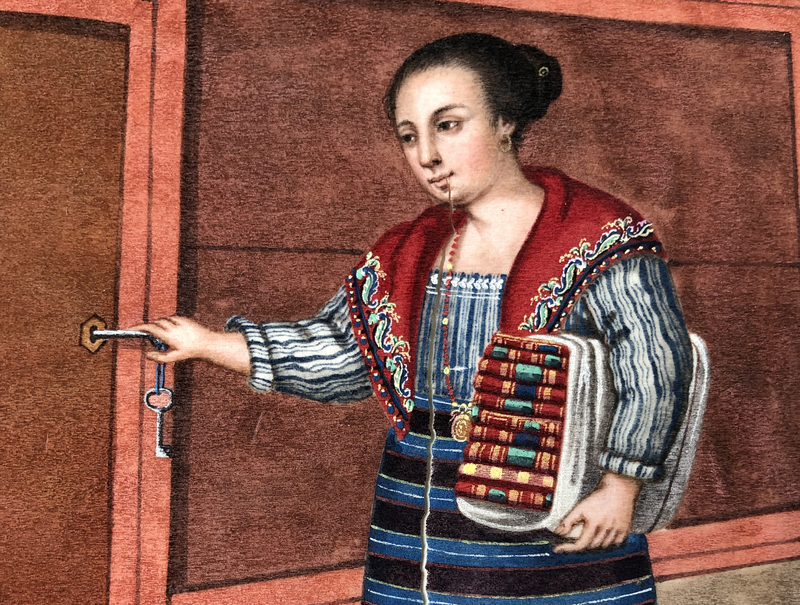
From Colección de trajes [de] Manila y de las provincias ynbentado por D. Rafael Daniel Baboom y dibujado por D. Damian Domingo page 21 of the Manila Album. V&A Museum, National Art Library, MSL/1984/27/3 © Victoria and Albert Museum, London This watercolour piece is unlabelled in the V&A album but is similar to Mistisa Mercadera de Manila - A Mistisa Shopkeeper from the Newberry Album.
In the course of mapping Philippine material culture in collections outside the Philippines, we came upon an entry in the UK’s National Art Library (administered under the Victoria and Albert Museum) for a Coleccion de trajes Manila y de las Provincias Ynbentado, [1826] . The entry attributed the three-volume bound album of original watercolour paintings to Damian Domingo. If this attribution turned out to be accurate, the albums would be a previously unknown set of watercolours by one of the most well-known 19th century Filipino artists of all time. In the art market, works by Domingo (born in Tondo, Manila c. 1790-1830), who has been designated as the “Father of Philippine Painting” are all highly valued and command some of the highest prices for 19th century art in the Philippine market.
There are however, only a few Damian Domingo pieces that are of unquestioned authorship. Aside from some oil paintings, his depictions of Philippine men and women in their “costumes” in a genre called tipos del pais or “country types” seem to make the bulk of his work. Usually gathered into albums, the watercolours illustrate the native dress of "indios” and "mestizos" from diverse social classes in Manila and other parts of the Philippines, including Pampanga, Ilocos, Pangasinan, and the Visayas.
Currently, there are several extant Tipos del Pais albums that are attributed (or misattributed) to Damian Domingo. Three are in the Philippines: the Paulino Que Collection (the subject of a monograph entitled Damian Domingo’s World by Nick Joaquin) and the Ayala Album (now reclassified by the Ayala Museum as from Damian Domingo’s atelier) and the Eleuterio Pascual Album which is currently on loan at the National Gallery in Singapore. Two albums are in the United States: the Ayer Collection at the Newberry Library (digitised by the Newberry and available here) and the ones kept at the New York Public Library (although the watercolours here are mostly assigned to Justiniano Asuncion, born in Manila, 1816-1901, and said to be a pupil of Damian Domingo). The album at the V&A would be the 5th and the most recently discovered album in this line-up. It is also the only one kept in a European institution thus far.
The collection at the V&A consists of three leather bound volumes of hand-coloured paintings, each labelled Chili u(nd) Peru, Chili and Manila. The three albums are enclosed in a leather-bound slipcase with “Original Paintings on Rice Paper Showing the Costumes of Chili, Peru and Manila” in embossed letters on the spine. Inside the slipcase, Hyman Zucker is identified as the bookbinder and claims that the box is “Fireproof.” Research has yielded that Zucker is a prominent Philadelphia bookbinder in the early 1900’s.
The three volumes open with a bright green fly page with the bookplate of Hermann Marx (c.1881 – 24 August 1947), a German-born British stockbroker, banker, and a noted print and book collector. Hermann Marx was a financier and set up trading companies that did business with Latin America and Asia. His clients included big names such as Chester Beatty and Calouste Gulbenkian, a British-Armenian businessman and philanthropist. When Marx died in, Surrey, on 24 August 1947, he left an estate valued at £1,262,492 (equivalent to £52,550,796 in 2021) and his hobby as a book and print collector yielded a posthumous sale of prints at Sotheby's on 24 May 1948. It has not been established if the V&A album was part of that 1948 sale, but we do know that according to provenance records, the volume was purchased by the V&A from H. Crossley in Thornton Heath, Surrey on 15 May 1984 along with another album of French costumes.
Volumes for Chile and Peru and Chile
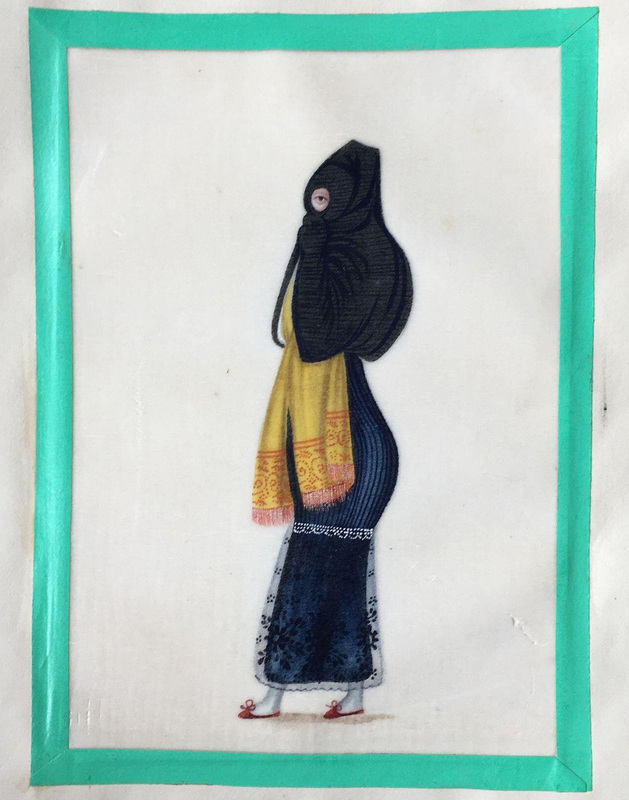
Colección de trajes [de] Manila y de las provincias ynbentado por D. Rafael Daniel Baboom y dibujado por D. Damian Domingo, vols 1-3, V&A Museum, National Art Library, MSL/1984/27/1-3 © Courtesy of the Victoria and Albert Museum, London
The album contains 30 watercolours, and while they depict similar ethnographic paintings of Peruvian and Chilean visual culture, the attribution to Domingo appears to be arbitrary. Nothing beyond their material genre as illustrative cultural surveys, indicates any artistic link between them and Domingo, except perhaps for the similarly rendered European facial features of some of the works., or the possibility that Hermann Marx, having businesses in both Latin America and Asia, could have aggregated these representations of all of places he had businesses in.
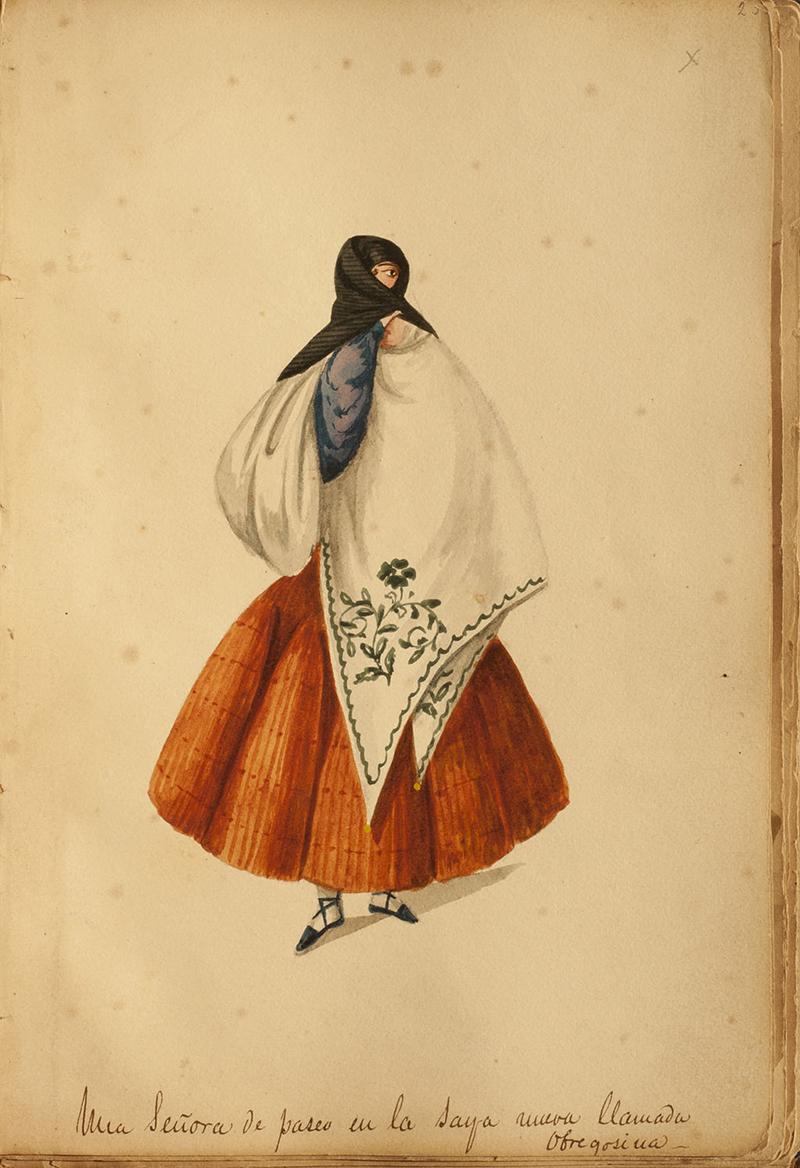
Signed watercolour by Pancho Fiero depicting a tapada Limeña.
A native artist whose fame may have been the same calibre as Damian Domingo, was the Peruvian artist Francisco Fierro Palas, called "Pancho" Fierro (c. 1807/1809, Lima – 28 July 1879, Lima). He was known primarily for his costumbrista watercolours, which depict Peru’s country life and customs. A comparison however between a signed Fiero with the ones at the V&A album show a difference in style, technical skill and detail. This clear difference led to looking for less obvious sources for the original manto de saya renderings. Surprisingly, a signed tapada was found in a published travel narrative by the Dutch writer Jacobus Boelen, a decorated marine officer who went on voyages to the East and West Coasts of South America, the Sandwich Islands and the Philippine Islands in the years 1826-1989.
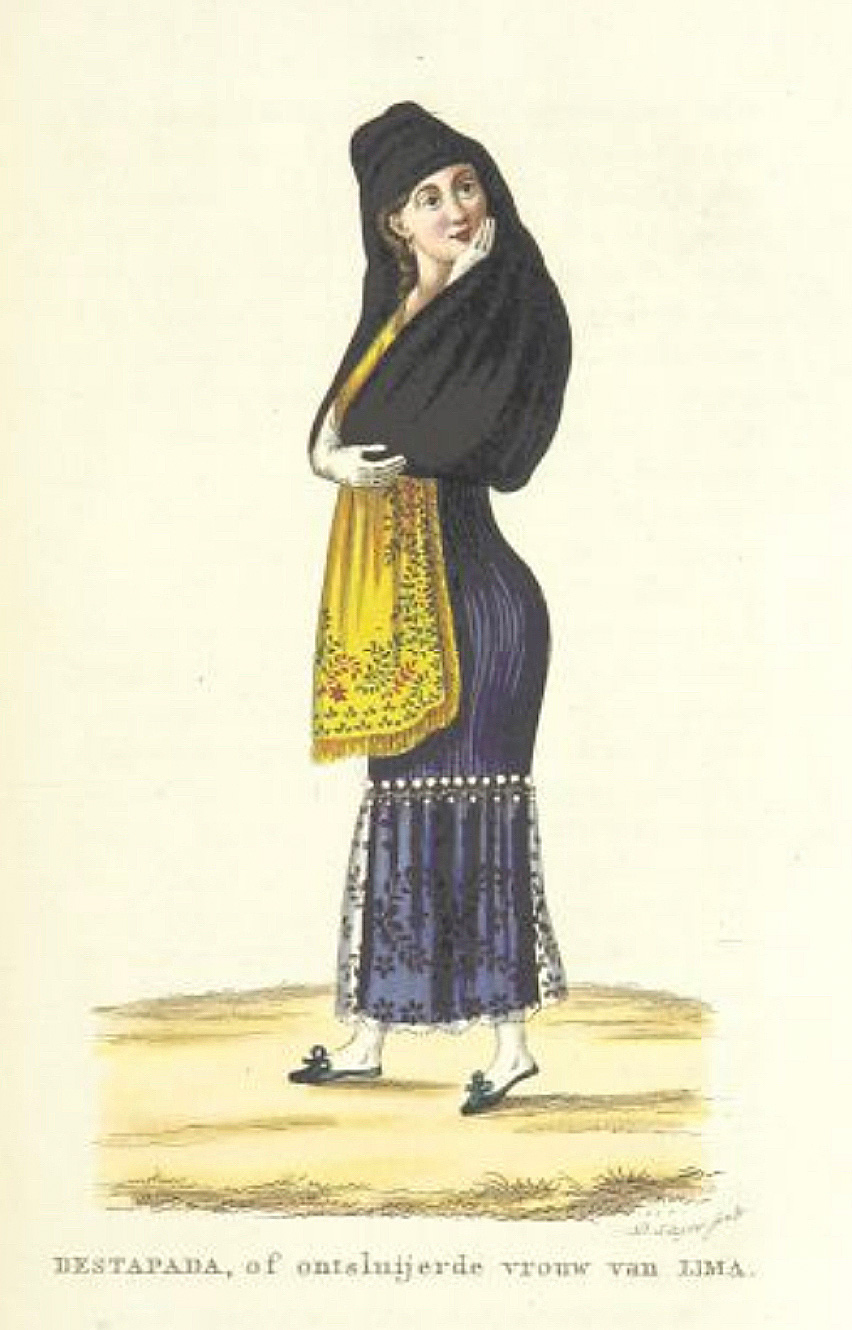
Signed watercolour rendering of a tapada Limeña by D. Sluyter in Boelen's travelogue.
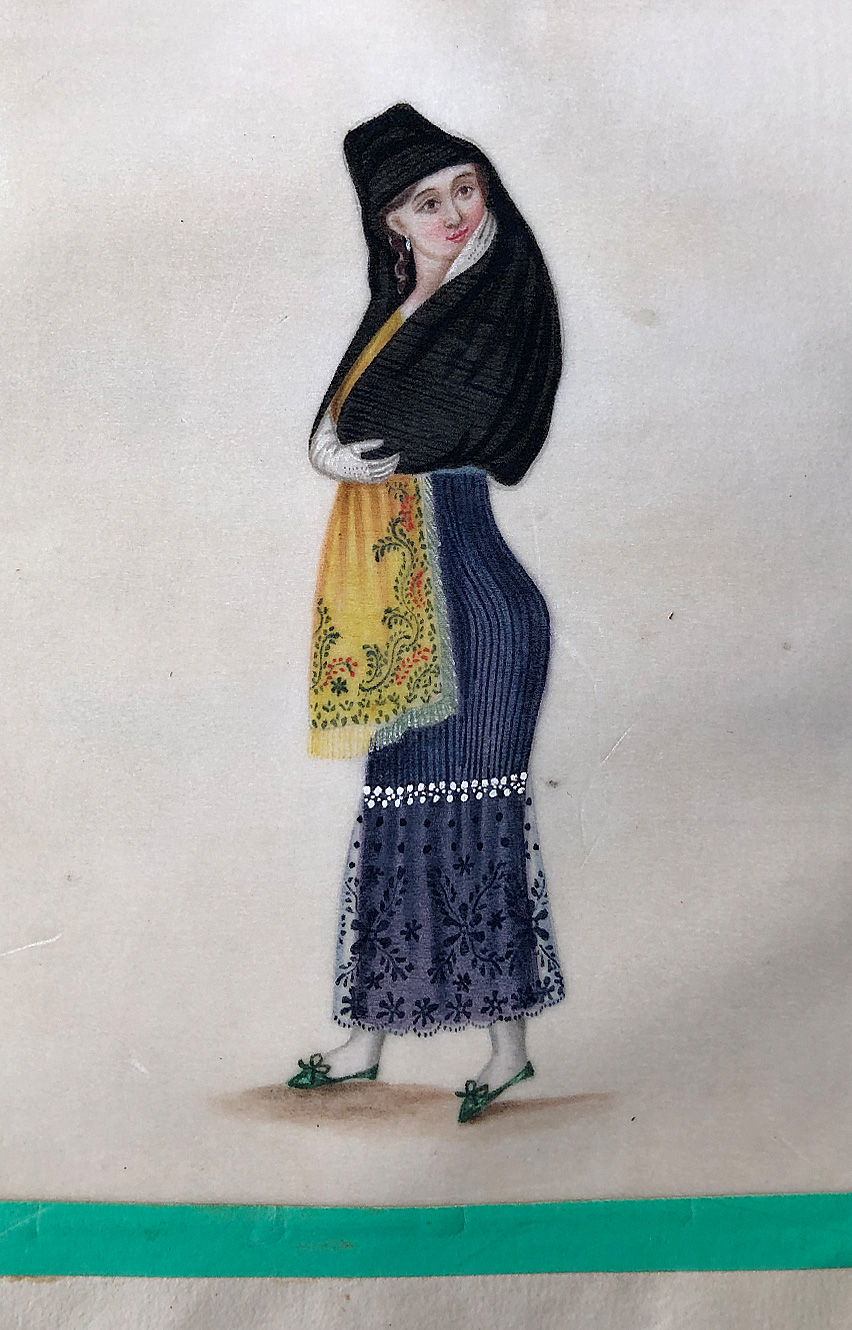
Colección de trajes [de] Manila y de las provincias ynbentado por D. Rafael Daniel Baboom y dibujado por D. Damian Domingo, Chile and Peru Album.V&A Museum, National Art Library, MSL/1984/27/1-3 © Courtesy of the Victoria and Albert Museum, London
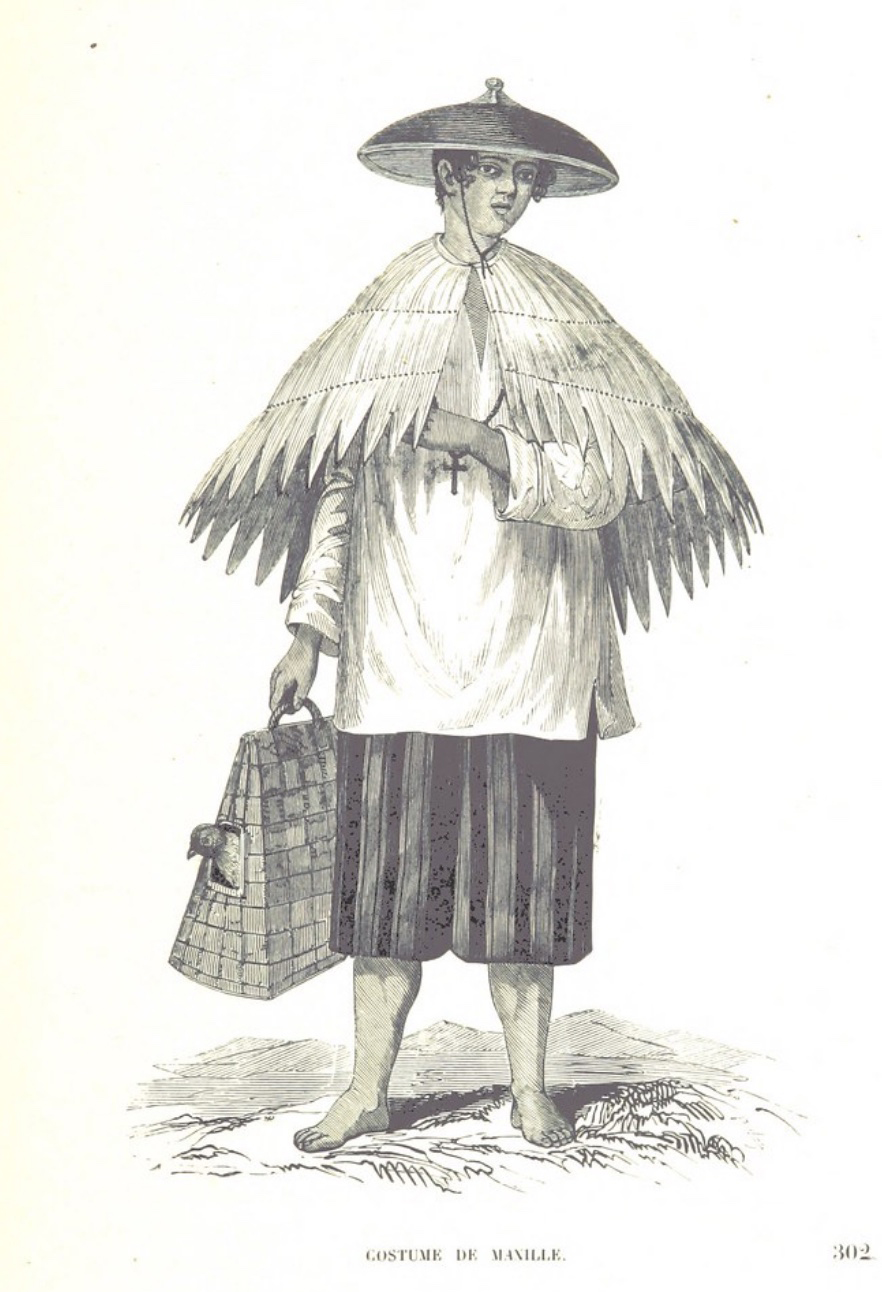
A black and white lithographic print of Justiniano Asuncion’s “Indio de Iloco”
Aside from this surprising European provenance for the manto de saya, it is interesting to note that within the same album, the other watercolours are clearly made by different hands. From renderings of horses to European facial features, to differing skill levels in depicting balance and proportion to muted and softer applications of colour, this album may have aggregated various copies of artistic renderings by different artists. Volume two which is also labelled Chili, has ten hand-coloured pieces, with similar materials as the first album (gouache on pith paper with the same green trim around.) At first glance these first two albums in this collection bearing Domingo’s name seem to have been curiously, and inaccurately lumped together with the Manila Album.
The Manila Album
a significant feature - as all the other extant albums designated as Chinese copies also have this No. 3 in the Title page. This designation as a Third of something has always mystified art scholars, and now for the first time, we may have an indication why. All the other albums everywhere did not come with the Chile and Peru albums and this significant historical detail only comes to us through the V and A collection.
The introduction in Spanish makes it clear that this is a collection of outfits (or “costumes”) from Manila and other provinces that have been invented or created for “Don Rafael Baboom” and painted by Don Damian Domingo, here identified as the director of the Art Academy established by the Economic Society of the Philippine Islands.
(Colección de Trajes Manila y de las Provincias Ynbentado por D. Rafael Baboom y dibujado por D. Damian Domingo, director de la Academia de Dibujo por la Real Sociedad Economica de (¿) las Islas Filipinas.)
The V&A Manila album has 30 watercolours painted with gouache on pith paper. The pith paper is thickly laid, and shows deep cracks through several of the paintings, perhaps from the tension caused by the green paper trimming that holds it down to the album page. The gouache retains a striking brilliance.
A Comparative Analysis
While the title page of the Manila volume formally attributes the watercolours to Damian Domingo (and the V&A museum replicates this attribution in its catalogue system), inter-textual art historical analysis as well as an examination of materials, iconography and style in relation to the other albums attributed to Domingo, will yield a different conclusion. Like the conclusions reached by Florina Capistrano Baker in her analysis of the Ayala Album, the rest of the essay will show that the V&A Manila Album is in fact, a copy based on the Philippine original now kept at the Newberry Library’s Ayer Collection.
Working with the general comparative observations established by Capistrano-Baker in distinguishing between the Newberry original and the established Damian Domingo copies (e.g. the Ayala album) a few observations about V&A album make it more similar to the Ayala rather than the Newberry original: none of the watercolours are signed, there is a misspelling of Rafael Daniel Babon’s name as ‘Baboom,’ and there are no captions in any of the V&A watercolours.
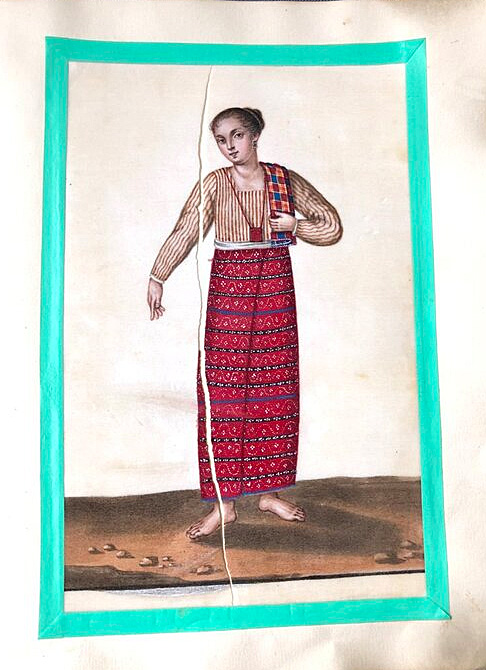
Cracked pith paper. India de Bisaya (An Indian Woman of Bisayas) shown left, the Manila Album, Colección de trajes [de] Manila y de las provincias ynbentado por D. Rafael Daniel Baboom y dibujado por D. Damian Domingo, V&A Museum, National Art Library, MSL/1984/27/1-3 © Courtesy of the Victoria and Albert Museum, London
A closer look at the technical skill and level of detail in the V&A compared to the Newberry album also yields some notable differences, mostly pertaining to the fine details (and lack thereof) in anatomical proportions, facial structures, the accurate representation of textile patterns, and of shadow placement.
On the left is the version held in the V&A, despite the more dramatic use of shadow the overall painting looks flat and two-dimensional in comparison to the work held in the Newberry (shown on the right). The drape and richness of the vibrant textile is expertly conveyed on the right, as is the detailed, delicate and ephemeral nature of the lace, unlike the head lace painted on the left which feels almost clumsily disconnected from the subject. The disproportionately small hands of the V&A piece can be compared to the more lifelike and elegant hands of the Newberry. There are also striking differences in fabric colour and pattern, the colour of the handkerchief, the locket, facial features, and the hair style.
Facial structure is different in these two depictions, as is the condition of the top hat. The worn-out hat on the right creates a sense of realism, whereas the shiny new hat on the left could serve as an example inside a fashion catalogue.
The artist’s skill is displayed well in the details. The Newberry on the right depicts expressive realism in hand in what is otherwise a very awkward and difficult posture to capture. While appearing seemingly effortless, this difficulty is recognised instantly in the V&A piece. With stiff, awkwardly placed fingers, the umbrella appears to bend and wrap around the arm.
A Better Copy?
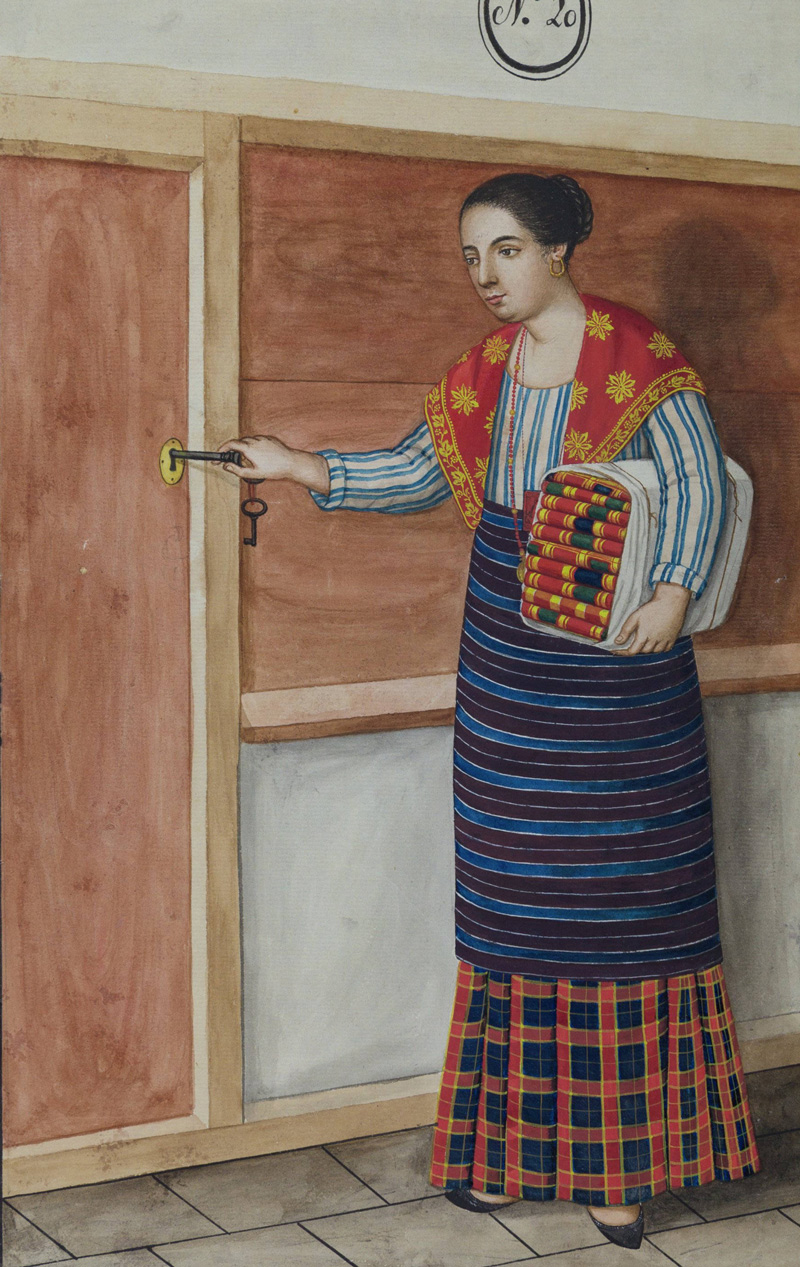
"Mistisa Mercadera de Manila” (A Mistisa Shop-Keeper) - Colección de trages de Manila, Newberry Library

"Mistisa Mercadera de Manila” (A Mistisa Shop-Keeper) - Ayala Collection
When a comparison is made among similar albums identified as copies, the V&A album is clearly very finely rendered work. The pith paper is thicker, and it seems to retain a brilliancy of colour that is unmatched in the other copy albums. There are also many ways that the V&A watercolours appear to have been rendered with a different kind of sophistication ( e.g. the facial features, the rendering of skin tones etc. ) This “hierarchy of copies” has rightly led scholars, like Florina H. Capistrano-Baker’s (Multiple Originals - Original Multiples; 19th century images of Philippine costumes, 2004:5) to question whether we might more accurately consider for instance, the V&A album paintings, as originals rather than just reproductions or replications. (1)
This suggests that the Eurocentric valuations of authenticity and originality need to be problematised. While wealthy collectors and aficionados covet the work of Damian Domingo's and that of his immediate circle, it is important to remember that at the time of their creation, they represented a popular genre of painting, inspiring many, especially in China, to produce work within this art tradition. What remains at least somewhat obscured is the real purpose of these images. As a whole, they might have represented a catalogue for European textile makers to copy as industrial production of clothing and trade increasingly powered national economies. Or they might equally have been items of status among the bourgeoisie that satisfied their curiosities concerning far away cultures. Or they might have been high end souvenirs for travellers and colonial officials to remind them of their time in Asia. Or, as seen in the Boelen travelogue, they could have been used as illustrations in a book.
There is no question that within Damian Domingo's ouvre are some of the most recognisable icons in 19th century Filipino culture. His work endures because of his mastery of the craft, the miniaturismo style so beautifully rendered within a body of work that radiates with simplicity and straightforwardness. Yet as material culture, there is historical and cultural value in the study of the entire genre- including its multiples. How can an analysis of the differences that are discernible in the depictions of dress or landscapes make us understand the 19th century Chinese art export industry better? How do these watercolours show the inter-embeddedness of Western supply and demand for information of exotic cultures ripe for extraction? What was the flow of materials - of watercolours and paper - through and between Canton and Manila and how did this affect the making of art? How did the economic landscape of 19th century Philippines and the role of the British in it, stimulate and affect the production of Philippine Tipos del Pais? Did Domingo have a view on the transnational copying and selling of his intellectual property? Did he even care?
*** It should be noted that when the V and A acquired the volume set in 1984, the catalog description designated the Manila volume as the first in the series. The V and A has retained this reverse sequence in its catalog description. To avoid confusion, here are the direct permanent links to the V and A Albums in the sequence in which it is catalogued:
- Vol. 1: https://collections.vam.ac.uk/item/O1460329/colecci%C3%B3n-de-trajes-manila-y-manuscript-rafael-daniel-baboom/
- Vol. 2: https://collections.vam.ac.uk/item/O1678796/colecci%C3%B3n-de-trajes-manila-y-manuscript-rafael-daniel-baboom/
- Vol. 3: https://collections.vam.ac.uk/item/O1678812/colecci%C3%B3n-de-trajes-manila-y-manuscript-rafael-daniel-baboom/
Bibliography
Florina H. Capistrano-Baker. Multiple Originals - Original Multiples; 19th century images of Philippine costumes, 2004, Ayala Foundation, The House Printers Inc, Makati Philippines.
For Bibliographic Citation Details of Florina H. Capistrano-Baker’s journal article Trophies of Trade: Collecting Nineteenth-Century Sino-Filipino Export Paintings about how the various albums are replicas see: https://read.dukeupress.edu/archives-of-asian-art/article-abstract/67/2/237/132863/
Stafford, Poole. Martín Enríquez de Almansa, Encyclopedia of Latin American History and Culture, vol. 2, p.500. New York: Charles Scribner's Sons 1996.
Antonio Garcia-Abasalo. Spanish Settlers in the Philippines (1571–1599), 3rd Congress of the Associacion Espanola De Estudios del Pacifico Lecture, Cordoba, 1995, http://www.uco.es/aaf/garcia-abasolo/files/63df3.pdf, accessed 08/2022.
https://nal-vam.on.worldcat.org/search/detail/1008040550?queryString=damian%20domingo&clusterResults=false&groupVariantRecords=false
https://collections.carli.illinois.edu/digital/collection/nby_eeayer/id/71001
* Kelly J. Sembrano Bailey is a second-year undergradute at SOAS. From February-June2022, she was an intern for the Mapping Project with funding generously provided by the SOAS Education Co-creator Internships from the office of the Learning and Teaching.
(1)this essay & stylistic analysis is informed by F Capistrano-Baker's research on the previously undocumented practice of Chinese replication of Filipino tips del pais first published in 2004 and 2022 webinar talk entitled "Hierarchy of Originals."
Explore items in Exhibit
Mistisa Mercadera de Manila - A Mistisa Shop-Keeper ___ Coleccion de trajes Manila y de las Provincias Ynbentado Watercolour Vol 1
Found on p.21, Manila volume; an album of watercolour drawings by Damián Domingo, probably commissioned between 1827 and 1832 by Rafael Daniel Babon, illustrating the native dress of “indios” and “mestizos” from widely diverse social classes and…
Mistisa Española de Manila - A Spanish Mistisa Woman ___ Coleccion de trajes Manila y de las Provincias Ynbentado Watercolour
Found on p.19, Manila volume; an album of watercolour drawings by Damián Domingo, probably commissioned between 1827 and 1832 by Rafael Daniel Babon, illustrating the native dress of “indios” and “mestizos” from widely diverse social classes and…
An Indian Pot-maker of Pasig — Watercolour from Colección de trages de Manila
"India Ollera de Pasig - An Indian Pot-maker of Pasig"
(p 37) From an album of watercolour drawings by Damián Domingo, probably commissioned between 1827 and 1832 by Rafael Daniel Babon, illustrating the native dress of "indios"…
India Ollera de Pasig - An Indian Pot-maker of Pasig ___ Coleccion de trajes Manila y de las Provincias Ynbentado Watercolour Vol 1
Found on p.37, Manila volume; an album of watercolour drawings by Damián Domingo, probably commissioned between 1827 and 1832 by Rafael Daniel Babon, illustrating the native dress of “indios” and “mestizos” from widely diverse social classes and…
Indio de Yloco - An Indian of Yloco ___ Coleccion de trajes Manila y de las Provincias Ynbentado Watercolour Vol 1
Found on p.43, Manila volume; an album of watercolour drawings by Damián Domingo, probably commissioned between 1827 and 1832 by Rafael Daniel Babon, illustrating the native dress of “indios” and “mestizos” from widely diverse social classes and…
Woman in Black Shawl — Coleccion de trajes Chili and Peru Watercolour Vol 3
Three volumes. Title on slipcase: Original paintings on rice paper [i.e. pith paper] showing the costumes of Chili, Peru and Manila. Volumes 2 and 3 contain armorial bookplates of Hermann Marx
Mounted Horsewoman — Coleccion de trajes Chili and Peru Watercolour Vol 3
Three volumes. Title on slipcase: Original paintings on rice paper [i.e. pith paper] showing the costumes of Chili, Peru and Manila. Volumes 2 and 3 contain armorial bookplates of Hermann Marx
An Indian Sugar Baker of Pampanga — Watercolour from Colección de trages de Manila
"Indio de Pampanga Aguarero -An Indian Sugar Baker of Pampanga" (p 39) From an album of watercolour drawings by Damián Domingo, probably commissioned between 1827 and 1832 by Rafael Daniel Babon, illustrating the native dress of…
An Indian Woman of Pampanga — Watercolour from Colección de trages de Manila
"India de Pampanga - An Indian Woman of Pampanga" (p 41) From an album of watercolour drawings by Damián Domingo, probably commissioned between 1827 and 1832 by Rafael Daniel Babon, illustrating the native dress of "indios" and…
A Mistiso of Manila — Watercolour from Colección de trages de Manila
"Mistiso de Manila - A Mistiso of Manila " (p 15 ) From an album of watercolour drawings by Damián Domingo, probably commissioned between 1827 and 1832 by Rafael Daniel Babon, illustrating the native dress of "indios" and…
A Spanish Mistisa Woman — Watercolour from Colección de trages de Manila
"Mistisa Española de Manila - A Spanish Mistisa Woman" (p 19) From an album of watercolour drawings by Damián Domingo, probably commissioned between 1827 and 1832 by Rafael Daniel Babon, illustrating the native dress of "indios"…
India de Bisaya - An Indian Woman of Bisayas (with Red Patadyong and Scapular) Coleccion de trajes Manila y de las Provincias Ynbentado Watercolour Vol 1
Found on p.53, Manila volume; an album of watercolour drawings by Damián Domingo, probably commissioned between 1827 and 1832 by Rafael Daniel Babon, illustrating the native dress of “indios” and “mestizos” from widely diverse social classes and…
Coleccion de trajes Chili and Peru Watercolour Vol 3 — Woman Smoking
Three volumes. Title on slipcase: Original paintings on rice paper [i.e. pith paper] showing the costumes of Chili, Peru and Manila. Volumes 2 and 3 contain armorial bookplates of Hermann Marx
Opening introduction (title page) of Manila volume ___ Coleccion de trajes Manila y de las Provincias Ynbentado Watercolour Vol 1
The original signed painting by Damian Domingo states different information in contrast with this particular copy. The one shown here also includes a misspelling of the commissioner's name 'Rafael Daniel Baboom' (the correct spelling…
Title Page for Colección de trages de Manila tanto antiguos como modernos, de toda clase de yndias
Title inscribed on a shield within an ornamental oval border. From an album of watercolor drawings by Damián Domingo, probably commissioned between 1827 and 1832 by Rafael Daniel Babon, illustrating the native dress of ""indios""…

